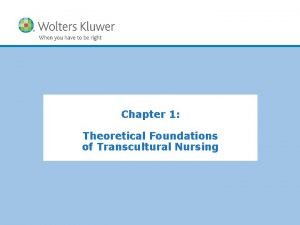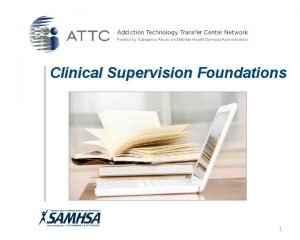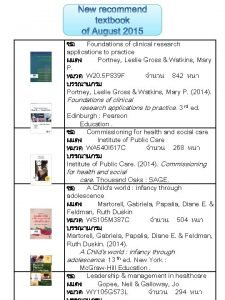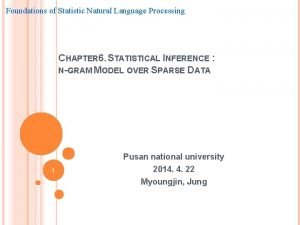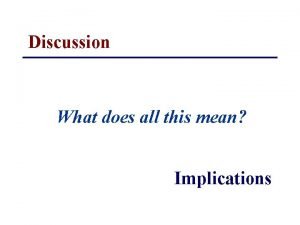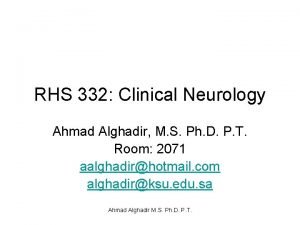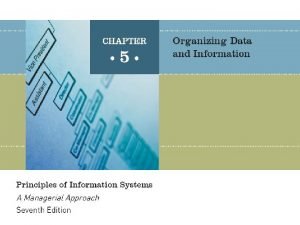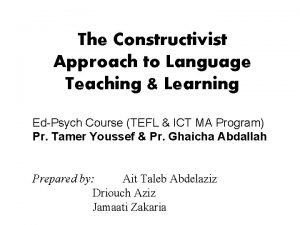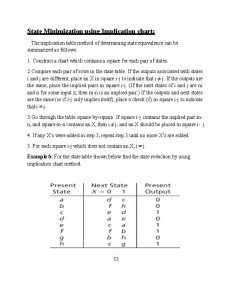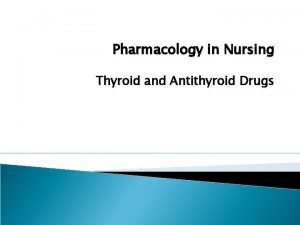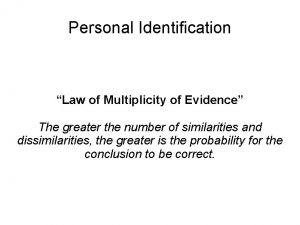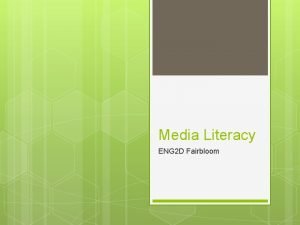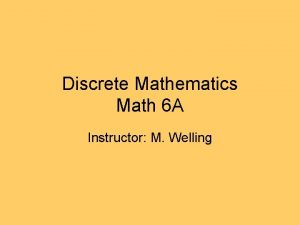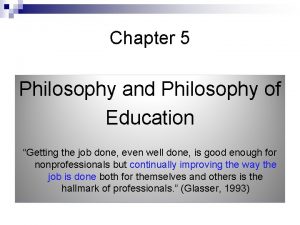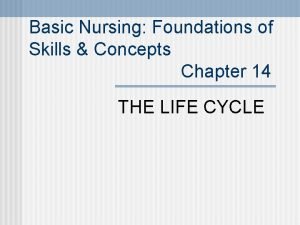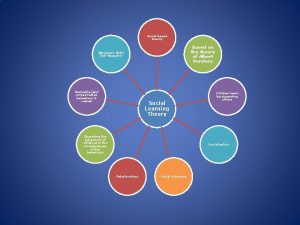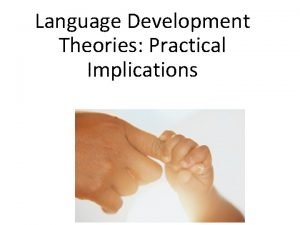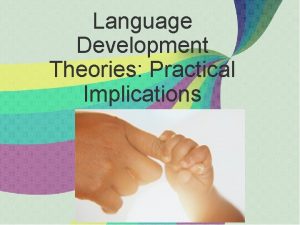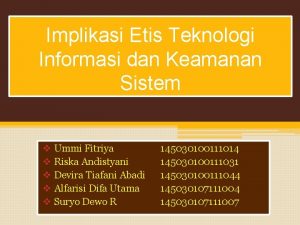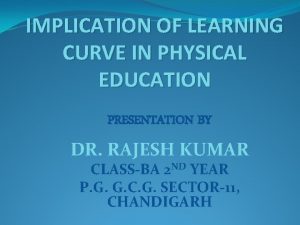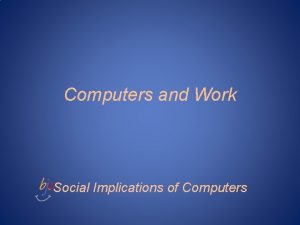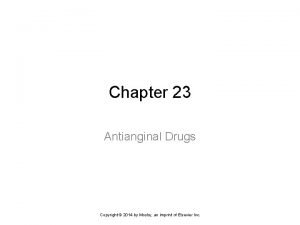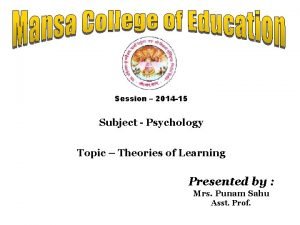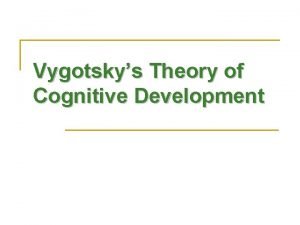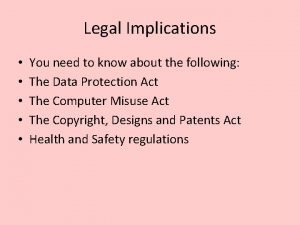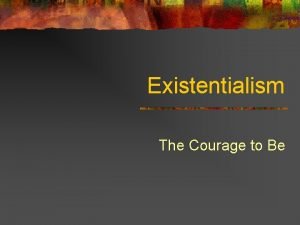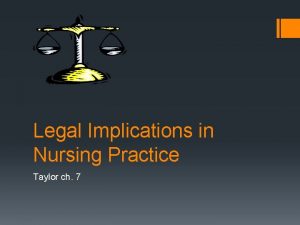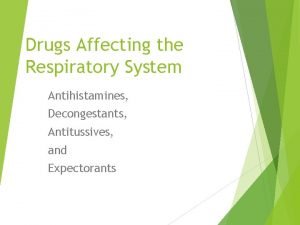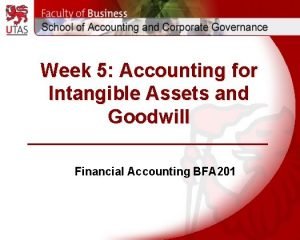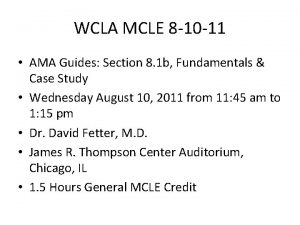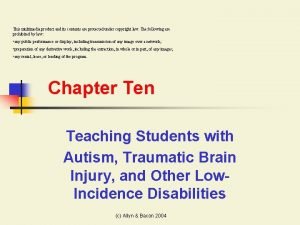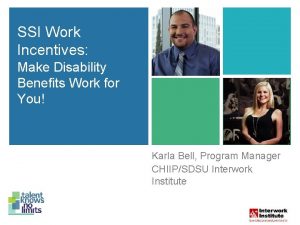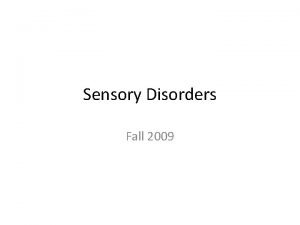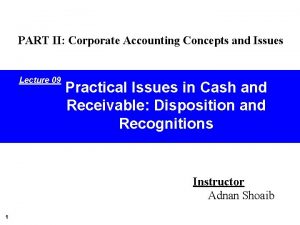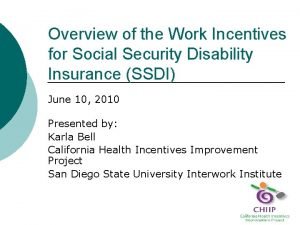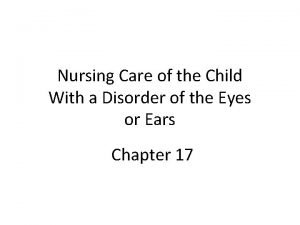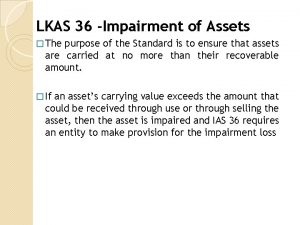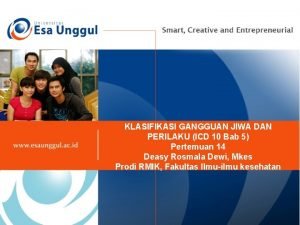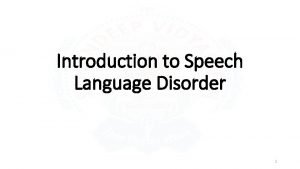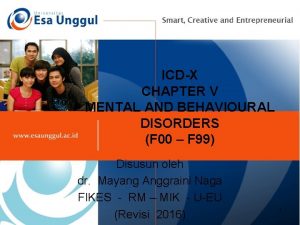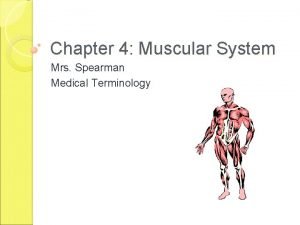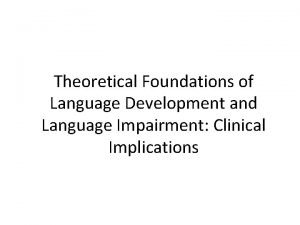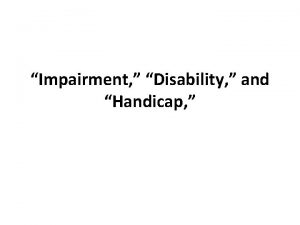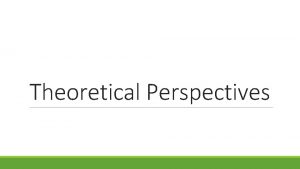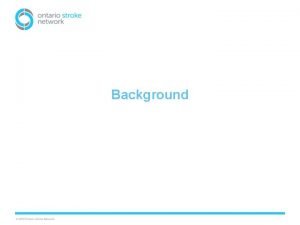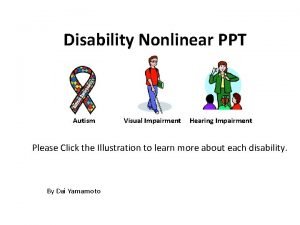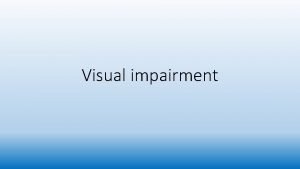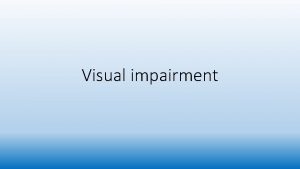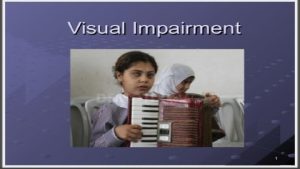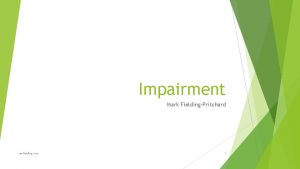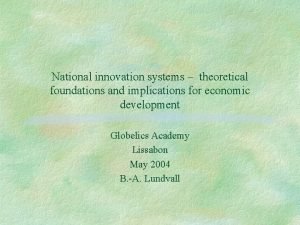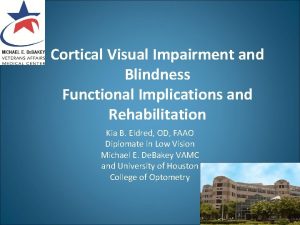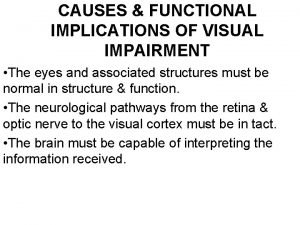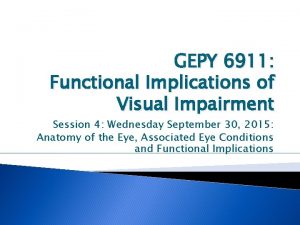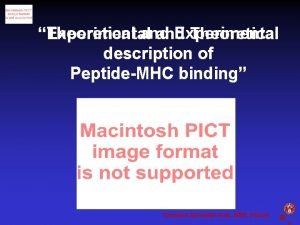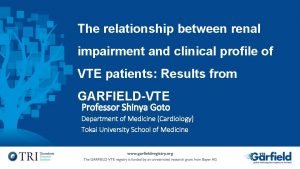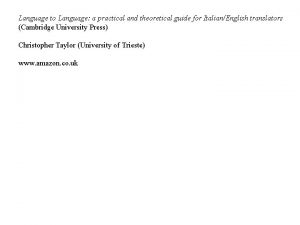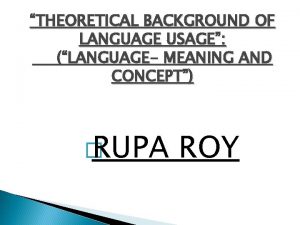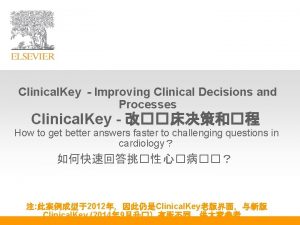Theoretical Foundations of Language Impairment Clinical Implications and






























































- Slides: 62

Theoretical Foundations of Language Impairment: Clinical Implications and Supporting Language Learning in Academic Settings

For test 1… • In chapter 2, you only need to read pp. 41 -52 • Stop at the bottom of p. 52

Power. Point Outline** • I. Introduction • II. Intervention: Playing the Game • III. Dynamic Assessment (review—CSAD 143) • IV. Systematic Learning Supports • V. Developing a Growth Mindset

I. INTRODUCTION: The Cone of Language Learning

** • If we focus on fixing the problem at the source or base of the cone, then when that problem is fixed, the impact of these interventions spreads upward • Medical problems are not within our scope, but we can indirectly refer (e. g. , for PE tubes, needed surgery, glasses, etc. )

II. INTERVENTION: PLAYING THE GAME** • In basketball, you have a series of tasks (run, dribble, shoot) • The end goal is to play the game well • Language is the same way—there are skills and strategies, but the end goal is effective communication in social and academic settings and living a productive and happy life

In the old days, you had 2 boxes: ** Whole language—immerse Behaviorist drill and kill, discrete trials, no context, lots of flashcards children in rich literature, but no direct teaching of skills

Hierarchical Skill Intervention

• Celeste Roseberry youtube channel • Using Drill to Improve Sight Word Recognition

Often, drill requires the child to imitate the SLP through use of elicited imitation: ** • SLP: Say “I see the boy petting the cat. ” • Child: “I see the boy petting the cat. ” • For years, we thought that was sufficient, but new research proves that there is more to it

Eisenberg et al. (2020). Use of imitation training for targeting grammar: A narrative review. Language, Speech, and Hearing Services in Schools, 51, 205 -225. ** • A meta analysis of 21 studies showed: elicited imitation ↑ effective than modeling in teaching new concepts to children with LI • But, ↓ carryover to conversational speech—children just ↑ accuracy in drill contexts

Eisenberg et al. 2020 recommended:

. Contextualized Skill Intervention** • Tx goals are explicitly addressed and also embedded in communicative contexts Goal: mix drill on explicit skills with whole activities such as a story, thematic unit (like Native American/First People tribes), and other classroom curriculum

RISE: ** • Repeated opportunities in an intense schedule with systematic support of explicit learning goals • Active engagement + multiple exposures = success! • Involves mixing whole and part activities along the way

Ukrainetz recommends combining drill and whole context learning—for example: ** • SLP drills on irregular plural cards (this is one mouse— these are 2____) (drill/parts) • Play a game of Go Fish with the cards (whole) • Child drills SLP with cards and tries to catch her doing them incorrectly (drill/parts) • Write/tell a story with the cards (whole)

The SLP and or teacher can do this… Narratives Literature-based intervention units Expository units (e. g. , dinosaurs or volcanos)

4 th grade science: recycling lesson** • Here are the vocabulary words you will use to work on plural –s: • Wastes, pollutants, plastics, amounts, habitats, beaches • On an index card, pick one of the words above and write how you will work on it in therapy using this paradigm: • 1. parts 2. whole 3. parts 4. whole

For example, with the word “beaches”** • 1. Part—have the child repeat these words after me: beaches, shells, grains of sand, rocks, waves (drill) • 2. Whole—Draw a picture that has all these objects and discuss the picture • 3. Part—Have the child create sentences using each word (e. g. , The shells are pretty. ) [drill] • 4. Whole—Watch a youtube video about conserving our beaches and discuss it afterwards, using the plural –s correctly

III. DYNAMIC ASSESSMENT** • DA evaluates a child’s ability to learn when provided with instruction • We use DA to determine whether a student has an underlying language impairment or is a typical learner with environmental issues • DA can tell us what kind of learning supports work best for each student

Review from 143, not on exam:

IV. SYSTEMATIC LEARNING SUPPORTS • A. Structural Learning Support

B. Interactive Learning Support** • 2 types: linguistic and regulatory scaffolds

1. Linguistic scaffolds (p. 94)

2. Regulatory scaffolds** • Aimed at helping the student become a better learner • Includes developing sustained attention, helping her manage challenges

Regulatory scaffolds in the classroom— choosing the quiet corner:

Regulatory scaffolds can include growth mindset work** • This is based on the research of Carol Dweck at Stanford • I have been using it very effectively for the last few years with ages 3 -20

V. DEVELOPING A GROWTH MINDSET(regulatory scaffolds)

When children are little: ** • High levels of warmth and nurturance from caregivers promote bonding, attachment, and a secure foundation • However, when children reach early adolescence, motivated by a very different kind of nurturance— being challenged to work hard and improve themselves—a growth mindset

The research of Carol Dweck** • Divided people: 1) fixed mindset (FM), 2) growth mindset (GM) • FM: intelligence, other skills are inborn and static--not amenable to change

Those with a growth mindset…** • Believe that intelligence and overall skills can be improved with hard work • Students who believe that they can improve their intelligence and overall performance are more academically successful than those with a fixed mindset

• We have believed for years in a “fixed brain, ”** or that we are born with a certain fixed amount of innate intelligence • Recent findings in neuroscience and cognitive psychology show: the brain has a great deal of plasticity and can be taught, even into older age • (I love the story of a student’s grandma, who began studying Spanish when she was 80!)

In Dweck’s research…** • Conducted a study with low-SES 7 th graders in Texas. Over the school year, each student in the study worked with a college student mentor • Students in the control group heard standard messages about how drugs could interfere with academic achievement

Students in the experimental group…

Again, the experimental students heard that: ** • The brain is like a muscle-- grows stronger with use • Every time you stretch yourself and learn something new, brain forms new connections

In other words…** • Experimental group heard: intelligence is not fixed—it’s malleable, can be ↑with hard work, grit, and perseverance • Good study habits were also taught

The researchers reported that: ** • The image of new connections forming proved extremely motivating to the students in the pilot studies • They reported that as they paid attention in class or studied difficult material, they pictured their neurons growing new connections; and that when they considered not studying, they warned themselves that they would be missing a chance to form new connections

For example:

Students were taught that: ** • The brain grows new connections every time we face challenges and learn, and that great mathematicians and scientists are people who have engaged in this process more than other people

We can also explain that it’s like trees growing out to touch each other**

At the end of the year, Dweck et al compared the 2 groups’ scores on Texas’ standardized achievement tests:

The researchers concluded: ** • It is important, particularly if this era of high stakes testing continues, for students to understand that these tests assess current skills and not long-term potential to learn • This is critical since many students make their disappointing achievement test scores as a measure of their fixed, underlying ability and become discouraged about their academic futures

Interestingly, the researchers also found that: ** Students with a fixed mindset are threatened by challenges, effort, and mistakes--these are things threaten to reveal the limits of students’ ability • We portray effortless achievement as the sign of true talent. Many bright students, praised for their easy successes, may believe that they are gifted only when things come easily to them.

We can help students by…** • Teaching them about the new science of brain plasticity and the new view of talent and giftedness as dynamic attributes that can be developed. • Too often, the brain is believed to be static, and talent and giftedness are seen as permanent, unchanging personal attributes that automatically bring later success •

• **Our research (Cimpian, Arce, Markman, & Dweck, 2007; Kamins & Dweck, 1999; Mueller & Dweck, 1998) has shown that giving students praise for their intelligence, as opposed to praise for process (such as effort or strategy) makes students think that their abilities are fixed, makes them avoid challenging tasks (so they can keep on looking intelligent), makes them lose confidence and motivation when the task be-comes hard, impairs their performance on and after difficult problems, and leads them to lie about their scores afterwards. •

On the other hand….

Process praise is best:

• **Process praise contributes to much better outcomes than intelligence or product praise • “You are such a hard worker. I’m really excited about how you’re stretching yourself now and working to learn hard things. ” • It may take more time for you to catch on to this and be comfortable with this material, but you if you keep at it like this you will. ”

I never say:


Examples of what to say: ** • “Let’s go around and have each of you share something hard you learned today that you didn’t know before. ” • “Who had a good struggle? Let’s share what we struggled with today” • “Get ready for a terrific struggle! Are you ready? Here we go. ” • “That was a lot of hard work. Can you just imagine all the connections you grew today? ” • “Who thinks they made a really interesting mistake? ” • “Who else made a terrific mistake that will help us learn? ”

Me with a defiant (and huge!) 15 -year old with Fetal Alcohol Syndrome and a history of violence: ** • Dr. R. : “Kiree, I want you to do 50 productions of sentences with slow, careful speech. ” • Kiree: “No way. I can’t. ” • Dr. R. : (after the hour was up): “Just so you know, you did 120 good productions. You didn’t even think you could do 50! Look at you! “

Recent research concludes:

A new study cautions that too much screen time can decrease students’ grit and perseverance** • Pressman, R. M. , Owens, J. A. , Evans, & Nemon, M. L. The American Journal of Family Therapy, 42 (5), 347 -363. • “Examining the interface of family and personal traits, media, and academic imperatives using the learning habit study. ” • They studied family routines in 46, 000 U. S. homes of children in grades K-12 via an online survey.

Major findings:


How have I helped students learn about grit?

Treston: 13 years old with repaired cleft palate** • Not doing his homework • Acting out in the group home • We did a trip to the future on the whiteboard • He wants to be a nurse and earn $100, 000 a year

Treston wants: ** • Nice home in a good area • Pug • Yard • Spouse • Food • Utilities • Vacations to Hawaii, Greenland, Iceland • We talked about how much all this would cost a year

How does he get there? He came up with all this and wrote it on the whiteboard himself** • Graduate from high school with good grades • Proper hygiene • Be organized and neat • Be active and exercise • Fulfill assigned tasks in the group home (which he wasn’t doing) • Do chores • Better social skills • Control his temper • Get better at bio/life science

I emphasized that if he wanted to be a nurse…** • People had to understand his speech! • Thus, carryover homework was imperative

For many kids…. ** • No one has ever connected the dots • No one has ever talked about what they want and the path to get it

If we have time…. ** • The 74 explains how to teach your baby grit • Youtube video • 13 -month old babies tried harder on a difficult task if they saw an adult struggle and persevere on a hard task!
 Sunrise enabler
Sunrise enabler Clinical supervision questions
Clinical supervision questions Foundations of clinical research applications to practice
Foundations of clinical research applications to practice Accommodations for speech and language impairment
Accommodations for speech and language impairment Foundations of statistical natural language processing
Foundations of statistical natural language processing Collocation nlp
Collocation nlp Discussion and implications
Discussion and implications Icidh-1
Icidh-1 Difference between impairment and depreciation
Difference between impairment and depreciation Difference between impairment disability and handicap
Difference between impairment disability and handicap Database management approach
Database management approach Constructive tools examples
Constructive tools examples Implication chart
Implication chart Nursing implications for synthroid
Nursing implications for synthroid Multiplicity law
Multiplicity law Eng2d media unit
Eng2d media unit Marketing implications
Marketing implications Tautological implications
Tautological implications Math
Math 5 philosophy of education
5 philosophy of education Marketing implications
Marketing implications Nursing implications
Nursing implications Bandura social learning theory 1971
Bandura social learning theory 1971 Legal implications of social media
Legal implications of social media Implications of nativist theory
Implications of nativist theory Implications of nativist theory
Implications of nativist theory Implikasi etis dari teknologi informasi
Implikasi etis dari teknologi informasi Educational implications of learning curve
Educational implications of learning curve Implications of quantum entanglement
Implications of quantum entanglement Social implications of computers
Social implications of computers Legal implications of nursing documentation
Legal implications of nursing documentation Ranexa nursing implications
Ranexa nursing implications Humalog nursing implications
Humalog nursing implications Classical conditioning theory
Classical conditioning theory Guided participation vygotsky
Guided participation vygotsky Medical implications of developmental biology
Medical implications of developmental biology What are legal implications
What are legal implications Nietzsche on existentialism
Nietzsche on existentialism Trends and issues in nursing
Trends and issues in nursing Dromotropic
Dromotropic Legal dimensions of nursing practice
Legal dimensions of nursing practice Future implications definition
Future implications definition Benzonatate nursing implications
Benzonatate nursing implications Fluconazole nursing implications
Fluconazole nursing implications Aasb 138 intangible assets
Aasb 138 intangible assets Ama impairment rating chart
Ama impairment rating chart Other health impairment definition
Other health impairment definition Ama impairment rating chart
Ama impairment rating chart Impairment related work expenses
Impairment related work expenses Nursing diagnosis for vision impairment
Nursing diagnosis for vision impairment Impairment loss on receivables
Impairment loss on receivables Impairment related work expenses
Impairment related work expenses Myringotomy incision
Myringotomy incision Nursing diagnosis cataract nursing care plan
Nursing diagnosis cataract nursing care plan Nursing diagnosis for vision impairment
Nursing diagnosis for vision impairment Lkas 36 impairment of assets
Lkas 36 impairment of assets Icd 10 cognitive impairment
Icd 10 cognitive impairment Impairment vs disability vs handicap
Impairment vs disability vs handicap Icidh adalah
Icidh adalah Icd 10 mata kedutan
Icd 10 mata kedutan Moderate renal impairment egfr
Moderate renal impairment egfr Hearing impairment meaning
Hearing impairment meaning Define myocele
Define myocele
